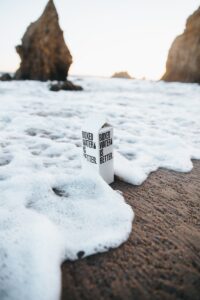Sea water is often thought to have healing properties for various skin conditions, but for those with seborrheic dermatitis, it may actually worsen the problem. One reason sea water may be harmful to seborrheic dermatitis is that it can potentially disrupt the skin’s natural pH balance.
Skin typically has a pH level between 4.1 and 5.8, which is on the acidic side, while sea water is slightly alkaline. This imbalance could lead to increased inflammation and irritation in affected areas. Plus, salt in sea water can dry out the skin, exacerbating the itchiness and flakiness associated with seborrheic dermatitis.
There you go. What a spoiler. Might as well not write the rest of the article now.
But I did anyway.
And for those willing to read it, you have my everlasting gratitude for not letting my efforts go to waste. Let’s go:
What is sea water?
Seawater is water from a sea or ocean (duh). It’s a complex mixture of dissolved minerals, salts, and organic materials (like urine and poop), and its composition can vary depending on factors such as location (Alaska vs India), depth, and temperature.
Typically, seawater has a salinity of around 3.5%, which means that about 35 grams of salt are dissolved in every liter of seawater. Seawater also contains a variety of other dissolved substances, including magnesium, calcium, potassium, and sodium ions, as well as trace amounts of other elements and compounds.

Is sea water antifungal?
Sea water is chockful of beneficial compounds and living organisms. It’s no surprise that there are studies showing that sea water or isolates of sea water compounds show promise as an antifungal treatment.
For example, researchers found a molecule called turbinmicin in the microbiome of a sea squirt from the Florida Keys that could potentially be a treatment for Candida. I didn’t know what a sea squirt was but I’m now a fan. They are so cute! Google them.
The high salt content in sea water can help to inhibit the growth of certain types of fungi. Some studies have shown that certain compounds found in sea water, such as bromine and iodine, may also have antifungal properties.
However, there are no studies, human or lab, showing that sea water is effective against Malassezia. Sea salt, specifically Himalayan sea salt or dead sea salt, holds some promise as skin treatment, but these are purified compounds, not the regular sea water you get by the beach.
Sea water and skin conditions
Sea water contains minerals, such as sodium, chloride, sulfate, magnesium, and calcium, which can be beneficial for certain skin conditions, like eczema. Some people claim that swimming in the ocean helps their skin rash significantly after.
I’m willing to bet they didn’t have seborrheic dermatitis.
Why sea water is bad for seborrheic dermatitis
While it has been found to benefit certain skin conditions due to its antiviral, antibacterial, and wound-healing properties, sea water doesn’t possess the strong antifungal properties needed to tackle seborrheic dermatitis.
Effective treatments for seborrheic dermatitis typically involve the use of antifungal agents, such as ketoconazole and clotrimazole to reduce the number of Malassezia yeasts on the skin and alleviate symptoms. Sea water would never be classed as an antifungal in this dimension.
While sea water is an osmotic agent and theoretically it could draw out moisture from the yeast cells, killing it, sea water may also create an micro-environment that Malassezia can thrive in. Skin typically has a pH level between 4.1 and 5.8, which is on the acidic side, while sea water is slightly alkaline. This imbalance could lead to a change in skin microbiome and increased inflammation.
Plus, exposing your skin to sea water may worsen seborrheic dermatitis as it can be drying and irritating to already sensitive skin. Sea water, which can be abrasive due to its high salt content, could potentially cause further irritation and inflammation if you spend too much time swimming in the ocean. The salt in sea water can strip away your skin’s natural protective barrier, leaving it more susceptible to irritation.
Also, ocean water can be contaminated with animal waste, sewage spills, stormwater runoff, fecal matter, and germs. During a seb derm flare, your skin barrier is already damaged. You run a high risk of these contaminants absorbing into your blood stream.
All this to say, you should not use sea water to treat seborrheic dermatitis. Thank you.
If you really want to use salt for your Seb Derm rash, consider Epsom Salt or Himalayan Salt instead. Even then, you should only use salt in limited ways to prevent aggravating Seb Derm.
Pingback: Is sea buckthorn oil good for seborrheic dermatitis?
Pingback: Seawater makes Seb derm worse (09/04/2023)
Pingback: Himalayan salt seborrheic dermatitis